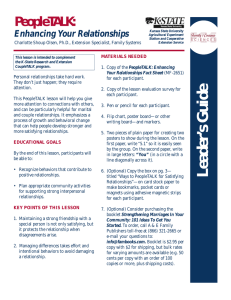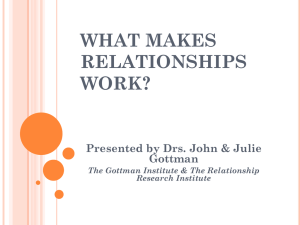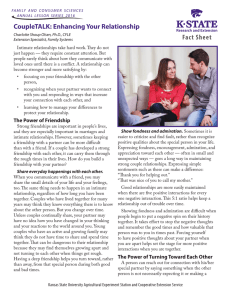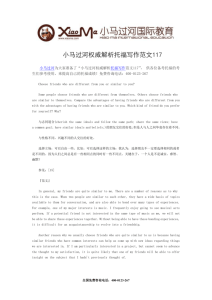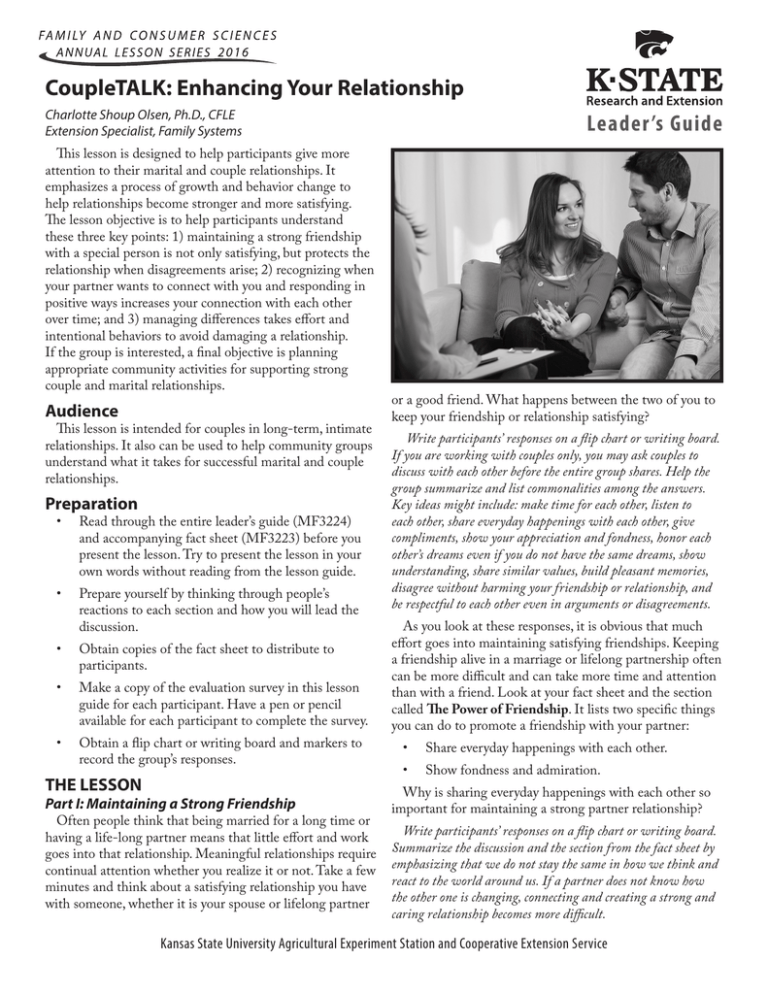
CoupleTALK: Enhancing Your Relationship
Charlotte Shoup Olsen, Ph.D., CFLE
Extension Specialist, Family Systems
This lesson is designed to help participants give more
attention to their marital and couple relationships. It
emphasizes a process of growth and behavior change to
help relationships become stronger and more satisfying.
The lesson objective is to help participants understand
these three key points: 1) maintaining a strong friendship
with a special person is not only satisfying, but protects the
relationship when disagreements arise; 2) recognizing when
your partner wants to connect with you and responding in
positive ways increases your connection with each other
over time; and 3) managing differences takes effort and
intentional behaviors to avoid damaging a relationship.
If the group is interested, a final objective is planning
appropriate community activities for supporting strong
couple and marital relationships.
Audience
This lesson is intended for couples in long-term, intimate
relationships. It also can be used to help community groups
understand what it takes for successful marital and couple
relationships.
Preparation
•
•
•
•
•
Read through the entire leader’s guide (MF3224)
and accompanying fact sheet (MF3223) before you
present the lesson. Try to present the lesson in your
own words without reading from the lesson guide.
Prepare yourself by thinking through people’s
reactions to each section and how you will lead the
discussion.
Obtain copies of the fact sheet to distribute to
participants.
Make a copy of the evaluation survey in this lesson
guide for each participant. Have a pen or pencil
available for each participant to complete the survey.
Obtain a flip chart or writing board and markers to
record the group’s responses.
THE LESSON
Part I: Maintaining a Strong Friendship
Often people think that being married for a long time or
having a life-long partner means that little effort and work
goes into that relationship. Meaningful relationships require
continual attention whether you realize it or not. Take a few
minutes and think about a satisfying relationship you have
with someone, whether it is your spouse or lifelong partner
Leader ’s Guide
or a good friend. What happens between the two of you to
keep your friendship or relationship satisfying?
Write participants’ responses on a flip chart or writing board.
If you are working with couples only, you may ask couples to
discuss with each other before the entire group shares. Help the
group summarize and list commonalities among the answers.
Key ideas might include: make time for each other, listen to
each other, share everyday happenings with each other, give
compliments, show your appreciation and fondness, honor each
other’s dreams even if you do not have the same dreams, show
understanding, share similar values, build pleasant memories,
disagree without harming your friendship or relationship, and
be respectful to each other even in arguments or disagreements.
As you look at these responses, it is obvious that much
effort goes into maintaining satisfying friendships. Keeping
a friendship alive in a marriage or lifelong partnership often
can be more difficult and can take more time and attention
than with a friend. Look at your fact sheet and the section
called The Power of Friendship. It lists two specific things
you can do to promote a friendship with your partner:
•
•
Share everyday happenings with each other.
Show fondness and admiration.
Why is sharing everyday happenings with each other so
important for maintaining a strong partner relationship?
Write participants’ responses on a flip chart or writing board.
Summarize the discussion and the section from the fact sheet by
emphasizing that we do not stay the same in how we think and
react to the world around us. If a partner does not know how
the other one is changing, connecting and creating a strong and
caring relationship becomes more difficult.
Kansas State University Agricultural Experiment Station and Cooperative Extension Service
Ask the group to focus on the section on fondness and
admiration. Ask them to identify reasons why this is important
in couples’ relationships. Emphasize that it cannot be fake or
manipulative, and that true expressions of fondness, admiration,
encouragement, and appreciation help a couple elevate each other
to feel good about themselves and their relationship. Remind the
participants that couples who get in a negative pattern with
each other can be encouraged to remember past good times and
how valuable they were to each other. This may help them change
the pattern of negativity toward each other.
Part II: Turning Toward Each Other
Look at the section of the fact sheet on The Power of
Turning Toward Each Other. Emphasize that when a
partner is reaching out, the other one has three choices
of how to react. “Turning toward” protects a relationship.
“Turning away” or “turning against” make it much harder
to maintain togetherness in a relationship. Use the example
in the fact sheet or create one of your own to demonstrate
the differences among the three options. You could ask
participants to do a role play showing each of the responses
and how each response might make a person feel.
Part III: Managing Differences
What often harms friendship in a marriage or close
relationship is having a severe problem between the two of
you that cannot be resolved and does not go away. Discuss
the four final stages that either lead to separation and
divorce or to living in an unhappy situation.
•
•
•
•
•
2
•
•
•
The couple thinks of their marital problems as
extremely difficult.
Talking together about an issue seems useless. They
never make progress in resolving the issue or learning
to live with it, so each may try to solve the problem
independent of the other. Nothing gets better.
Their difficulties pull them away from each other
and they start leading parallel lives, not spending
time with each other, not talking to each other in
meaningful ways, not showing fondness toward the
other, nor sharing their everyday lives.
•
They each become lonely and do not reach out to
each other in good times and bad.
Ask the participants to look at the section on managing
differences in the fact sheet. Depending on the available time,
you can decide how much discussion to allow with the suggested
topics below.
•
•
What situations can you remember when you
brought up an issue with a partner or family member
at a very inappropriate time? How did the interaction
proceed?
How do you respond when your partner or a close
family member brings up a tough issue by saying,
“You never . . .” You always . . .” ? How can you
•
introduce a difficult topic without sounding accusing
or blaming? How can you be softer in your approach?
When you want to talk about a conflict with another
person, make the message short and address only one
issue at a time. You will lose the opportunity to open
a beneficial dialogue if your messages are lengthy
and cover multiple issues. Be alert to ways you can
soothe each other during a heated conversation,
even a response such as “I see.” Sometimes it can
keep a conflict from spinning out of control. What is
soothing to you during a tense conversation?
Always be respectful even in disagreement. Avoid
calling the other person names, being sarcastic,
degrading the other person, or bringing up issues of
the past as a way to criticize the other person. What
do you consider respectful and disrespectful during an
argument?
Some issues may require setting rules about your
discussion before it starts. What rules have worked
for you in your couple relationship (or family
relationship) when discussing difficult topics?
If you find the discussion getting out of control,
ask the other person for a time out so you can calm
down and not say things you regret later. Be sure to
set another time for resuming the dialogue and work
at having positive thoughts about the other person,
rather than dwelling on the conflict. You could get
yourself more worked up during the time out if
you do not force yourself to quit thinking negative
thoughts about the other person and the issue
between you. How does your body react when you
have strong negative emotions? How do you calm
your body during stressful situations?
Be willing to compromise in ways you both can live
with. This means you have to listen with an open and
honest ear to his or her perspective and feelings about
an issue. Compromising and letting the other person
influence you helps decrease the hurt and pain so the
problem does not eat away at the relationship. It also
helps develop understanding and patience with each
other’s faults.
Honor each other’s hopes and dreams. So many
problems between two people result from conflicting
hopes and dreams that have not been thoroughly
discussed. You may not agree with the hopes and
dreams the other person has, but showing you are
listening attentively may eventually open the door
for more discussion. Create an example to discuss
or use the following one: Your spouse wants to start
a business. You know there is not enough financial
backing. Your dream is that your spouse will be
satisfied with a regular job. How can you show
K-State Research and Extension — CoupleTALK: Enhancing Your Relationship, Leader’s Guide
respect and interest in the spouse’s hopes and dreams,
even though you may think the spouse is not being
realistic? Allow a few minutes for discussion. Two key
points to summarize the discussion are: 1) listening
attentively and respectfully when the spouse wants to
talk about this hope and dream; and 2) encouraging
dialogue so the two of you can understand each
other’s point of view.
Part IV: Helping Others in the Community
Build Strong Relationships
To Be One With Each Other
What greater thing is there for two human souls,
than to feel that they are joined together to strengthen
each other in all labor, to minister to each other in all sorrow,
to share with each other in all gladness,
to be one with each other in the
silent unspoken memories.
By George Eliot (Mary Ann Evans)
(edited version)
What can you do in your community to help and support
strong marriages and relationships? After identifying
some potential activities, what steps do you need to take
to make them happen? Discussion will vary with the type of
participants and what they feel is important. These suggestions
might help the group begin to identify activities that would
work for them.
•
•
•
•
•
Offer volunteer babysitting to young couples in the
community so they might have a date.
Establish a volunteer babysitting bank for working
parents who have a sick child.
Write Dear Abby or local advice columnists about
how relationships can be strengthened by focusing on
one or two ideas in this lesson.
Work with other groups to organize relationship
classes for couples in different stages of life.
Ask a local radio station to broadcast a Tip of the
Day for strengthening marriages.
Summary
Relationships take hard work. Having satisfying
relationships is more than sidestepping conflict. Healthy
relationships thrive in an atmosphere where each person
feels comfortable talking honestly and openly about things
important to him or her. In this way, minor issues can be
discussed before they become big issues that can damage
the relationship. Just as importantly, a satisfying relationship
is about having a sense of connection to the other person.
It is about spending time with the other person and talking
about each other’s hopes and dreams. Establishing rituals
that connect partners to each other is important as well. It
can be as simple as saying good-bye in a special way in the
morning as you go your separate ways or making a brief
time for each other to share the day’s events at the end of
the day.
CoupleTALK: Enhancing Your Relationship, Leader’s Guide
3
CoupleTALK: Enhancing Your Relationship Evaluation Form
Directions: Please answer the following questions; however, completing this survey is voluntary. You do not have to
answer every question. You will not be identified with your answers in any way.
1. How do you rate this lesson?
Check one: Excellent____ Good____ Average____ Poor____ No opinion____
2. Do you think this information will be useful to you in your own life?
Check one: Yes____ No____ If yes, how?
4. What did you learn that you did not know or that surprised you?
5. What have we left out in this lesson that you feel should have been included?
6. Will you share this information with others? Yes____ No____ If yes, check those that apply:
FCE ____ Other organization____ Family____ Friend____ Other____
7. A. Are you?: Female____ Male____ B. What is your age?____ C. Are you?: Single____ Married____ Single, living
with partner____ Separated or divorced____ Widowed____
Other comments about the lesson:
Thank you! Please give this survey to your lesson leader. The information you provided will help us improve family
life education. If you are interested in being contacted in the future on the impact of this lesson on your marriage or
relationship, please provide the following: Name
Address Phone Email
For Leaders Only:
Leader’s Name: ______________________ Phone Number or Email:____________ County:_____________________
Type of group: FCE ____ Other_________________________ Date when lesson was given:______________________
Number of people attending: ____ Number of Men:____ Number of Women:____
Please return completed surveys to your county/district Family and Consumer Sciences agent, or mail directly to:
Charlotte Shoup Olsen, Kansas State University, 343 Justin Hall, 1324 Lovers Lane, Manhattan, KS 66506
If questions, contact Dr. Olsen at colsen@ksu.edu.
Thanks to the following persons who reviewed this lesson:
Debra Bolton, Ph.D., CFLE; Rebecca McFarland, B.S.
Written by: Charlotte Shoup Olsen, Ph.D., CFLE
Extension Specialist, Family Systems
References available upon request.
Publications from Kansas State University are available at:
www.ksre.ksu.edu
Kansas State University Agricultural Experiment Station and
Cooperative Extension Service
Publications are reviewed or revised annually by appropriate faculty to
reflect current research and practice. Date shown is that of publication
or last revision. Contents of this publication may be freely reproduced
for educational purposes. All other rights reserved. In each case, credit
Charlotte Shoup Olsen, CoupleTALK: Enhancing Your Relationship,
Leader’s Guide, Kansas State University, August 2015.
K-State Research and Extension is an equal opportunity provider and
employer. Issued in furtherance of Cooperative Extension Work, Acts of
May 8 and June 30, 1914, as amended. Kansas State University, County
Extension Councils, Extension Districts, and United States Department
of Agriculture Cooperating, John D. Floros, Director.
MF3224 August 2015

